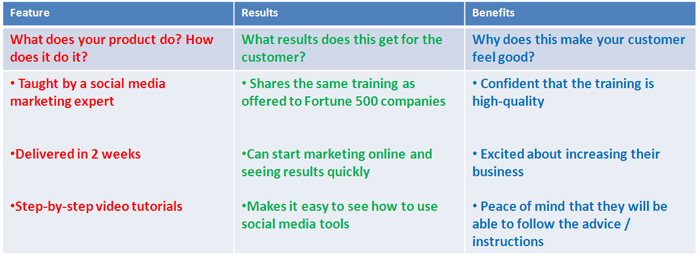
Benefits.
You hear a lot about them in content-marketing and copywriting.
Sell the benefits, not the features, make your benefits compelling, make sure your copy is loaded up with benefits.
We get it. Benefits are important.
But what the heck ARE benefits, and HOW do you actually include them in your copy?
I’m glad you asked (well I did, technically, just then) because I want to tackle this in a super-simple way that gets down to the nuts and bolts of this darn benefit-malarky.
What the heck is a benefit?
In basic terms, a benefit is what makes your customer feel good about buying your product.
Don’t worry, we’ll break this down into some more specific examples to help you in your content-marketing.
But before we do that, there’s something we need to do first.
Why you MUST know your customer first
If you don’t know your customer, you’re doomed to start when writing compelling benefits.
Benefits make your customer feel good about buying your product. Which means you must know what makes your customer feel good before you can link it to buying your thing.
Example time:
Sally and John are both looking for an online social media marketing training course.
Sally is a life-coach. She’s passionate about what she does and wants to get the message out about her business. But she’s nervous about coming across as pushy and wonders if she can fit social media into her day and handle the technology.
John runs a nutrition and fitness business. He’s confident when talking about his business. He loves online tools, values the opinion of an expert and wants to know how to use social media to get his message to the best people.
Both want the same overall result (social media marketing training). Both could sign up to the same course and be happy with it.
BUT they will respond to different styles of copy and content-marketing.
For example, Sally may feel comfortable with the following write-up:
Cut through the overwhelm of social media marketing in this 2 week online course that teaches you how to attract more online customers using social media just 10 minutes a day. Our simple videos walk you through each step so you can be confident using social media technology, tools and techniques even after the first day. Our personality coaches also help you find your natural voice online. Whether you love the limelight or are quietly passionate we can help you connect and engage authentically with your perfect customer online.
What makes Sally feel good about signing up to the course?
- Confident she can learn the technology
- Peace of mind that she only needs a few minutes a day to make it work
- Relief that she doesn’t have to be someone she isn’t online
Now let’s look at how we might write about the same product to appeal to John:
Get social media marketing licked in this course that has you dominating your field online in just 2 weeks. Taught by a best-selling author and social media advisor to XXX company, you can feel confident you’re getting Fortune 500 training on a small-business budget. You’ll master the best social media marketing tools available to reach, engage and charm your ideal customer online.
What makes John feel good about signing up to the course?
- Confidence in the product because the course is run by an expert
- Excitement at learning new online technology
- Motivated that he’s going to be able to start marketing to people quickly
You can see how customer interests and desires will influence different copywriting styles so it’s really important that before you write about the benefits you revisit (even quickly) your customer profile.
Once you’ve done that, here’s a simple way to write compelling, credible benefits:
3 essential ingredients for credible benefits
If you read copywriting advice, you’d be forgiven for thinking benefits are ALL that matter. That the lowly feature has no place in your content-marketing.
That’s not true. In fact, your features are very important because they add credibility to your claims.
In the above example of writing to Sally, if we simply wrote:
Cut through the overwhelm of social media marketing
It wouldn’t be strong enough on its own. We hear so many promises online, it’s easy to dismiss great claims.
But because we explain the course is completed quickly, we provide proof of HOW we cut through the overwhelm.
Which leads us to the 3 essential ingredients of compelling, credible benefits:
- Features – What your product does / what it has
- Results – What results that feature produces
- Benefits – Why this makes your customer feel good
By using all 3 together you make sure you’re appealing to those emotional triggers by mentioning benefits, and you’re backing up your claims with plenty of proof through the features and results.
An easier way to illustrate this might be in a good old-fashioned table.
Put them all together et voila!
If you take the time to split up your features, results and benefits it makes it so much easier to write about the benefits in your copy.
All you have to do, is then include all 3 parts to get some straight-talking, non-hypey but compelling (and credible) benefits.
And the best part is you can write them out simply in the format of feature, result, benefit. For example:
The course is taught by a best-selling author and social media expert. She shares with you the same training as she does with her Fortune 500 clients. This means you can feel confident that the training is high-quality.
Or you can mix them up, say benefit, result, feature for example:
Get excited about increasing your business, and see results quickly. With the whole course delivered in 2 weeks you can start marketing online, fast!
So there you go, a simple way to pin down those pesky benefits.
So come on, get your benefits out! Let me know how you get on below

Thanks for this! I’m new to copywriting so I’m thankful for all these great tips! This one, in particular, is helping me on some product copy I’m writing at the moment.
I can never quite grasp the difference between results and benefits. It seems like you’re saying that a benefit is an emotional outcome. Would that be accurate? If so, that makes sense to me and is very helpful.
What then is a result? All those you list in the table you could also say are benefits by my definition of the word. Would another way of defining “benefit” in this context be that a it is a practical effect of using the feature?
Thanks again for your generosity in sharing your knowledge!
Hey Scotty!
Great perception there. Powerful benefits tend to be emotion-driven which is what makes it an enjoyable challenge to pin them down. When you get it right, it’s very effective. Results are kind of like the facts about what happens.
For example I buy a pair of shoes, the result is I have new shoes for a party, but the benefit is how I feel in those new shoes when I walk through the door – proud, attractive, confident… That’s the area you want to spend time on when you’re getting to the bottom of benefits 🙂